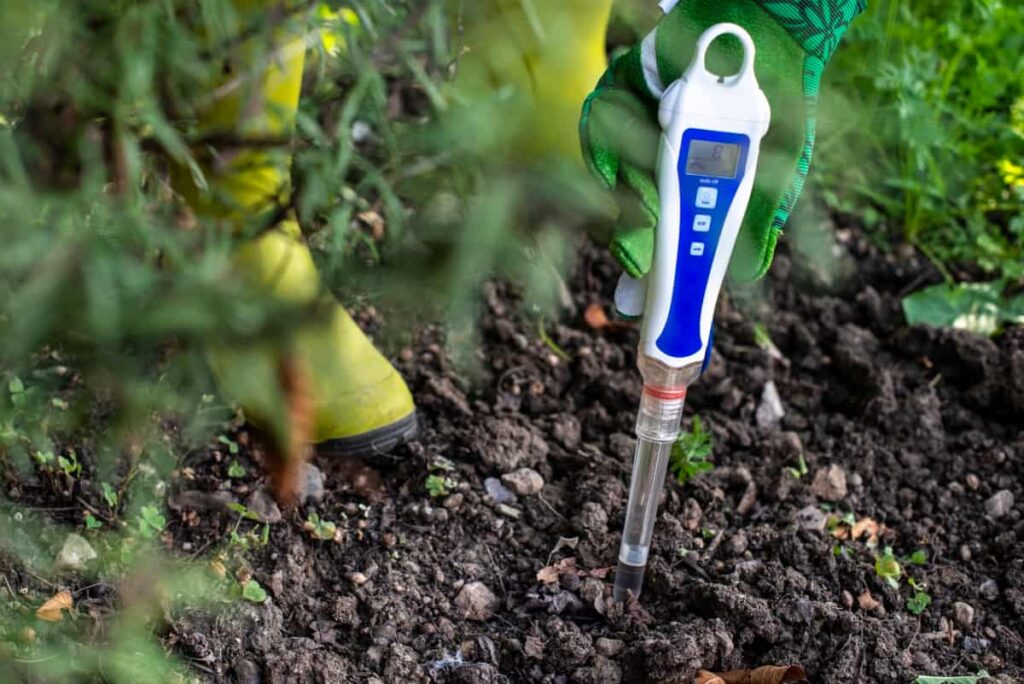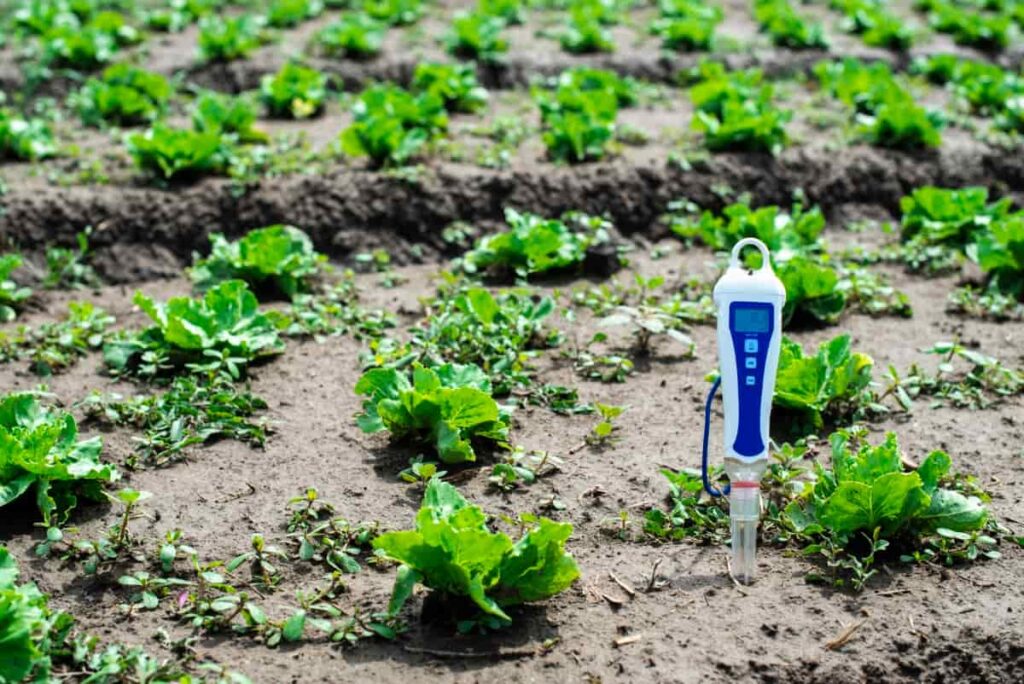In the realm of cultivating healthy plants, understanding and managing soil pH is paramount. Soil pH, a measuring of acidity or alkalinity, profoundly influences nutrient availability and plant growth. Delving into the intricacies of soil pH modification unveils a spectrum of techniques – 14, to be precise. From balancing to lowering or elevating pH levels, these methods serve as horticultural alchemy. Let’s embark on a journey through these transformative approaches, decoding the secrets that cultivate thriving soils and flourishing plants.

Soil pH Modification Techniques
What is the Soil pH Modification Technique?
Soil pH modification techniques refer to a set of practices aimed at altering the acidity or alkalinity of soil to create an optimal environment for plant growth. The pH scale ranges from acidic (0-6.9) to neutral (7) to alkaline (7.1-14). These techniques are crucial, as soil pH profoundly affects nutrient availability. Features of these methods include the use of amendments like lime to raise pH for acid soils or sulfur for alkaline soils. Organic matter incorporation and cover cropping are other strategies. Precision is key, ensuring the pH aligns with specific plant needs.
Soil acidity is a common problem that affects crop production in many regions of the world. Various factors, such as high rainfall and leaching, acidic parent material, organic matter decay, and the harvest of high-yielding crops, can cause soil acidity. Soil acidity can have negative effects on plant growth, such as nutrient deficiency, toxicity of aluminum and manganese, and reduced microbial activity. Therefore, managing soil acidity is essential for improving soil fertility and crop productivity.
Advantages of Soil pH Modification Techniques
Soil pH modification techniques are methods to alter the acidity or alkalinity of the soil to improve its suitability for plant growth.
- They can increase the availability of nutrients and minerals in the soil, such as phosphorus, calcium, magnesium, and molybdenum, which are more soluble in slightly acidic soils.
- They can reduce the toxicity of certain elements, such as aluminum, manganese, and iron, which can harm plant roots and reduce crop yields in highly acidic soils.
- They can enhance the activity of beneficial soil microorganisms, such as bacteria, fungi, and earthworms, which help decompose organic matter and recycle nutrients in the soil.
- They can improve the soil structure and water retention capacity, which can prevent soil erosion and drought stress.
- They can expand the range of crops that can be grown in different soil types, which can increase crop diversity and food security.
Lime Application
Lime application is the most common and effective method of managing soil acidity. Lime is made up of calcium carbonate (CaCO3) or magnesium carbonate (MgCO3). These minerals can balance out the soil’s extra hydrogen (H+) and aluminum (Al3+) ions and raise the pH of the soil. Lime also supplies calcium (Ca2+) and magnesium (Mg2+) to plants, which are essential nutrients for plant growth and quality.
The lime application can improve soil physical, chemical, and biological properties, such as soil structure, water infiltration, nutrient availability, microbial activity, and crop yield. The amount of lime used to raise the soil pH depends on several factors, such as the initial soil pH, the target soil pH, the buffer capacity of the soil, the quality of the lime, and the method of application.
Soil testing is essential to determine the lime requirement of the soil. Generally, lime should be applied at least six months before planting acid-sensitive crops, such as legumes, to allow enough time for the lime to react with the soil.
Sulfur Amendment
- Sulfur amendment is a technique of lowering the soil pH by adding elemental sulfur (S) or sulfate-containing fertilizers, such as ammonium sulfate [(NH4)2SO4], to the soil.
- Soil bacteria oxidize sulfur or sulfate to produce sulfuric acid (H2SO4), which releases H+ ions into the soil solution and lowers the soil pH. The sulfur amendment can be used to create acidic conditions for crops that prefer low pH, such as blueberries, azaleas, and rhododendrons. The amount of sulfur required to lower the soil pH depends on several factors, such as the initial soil pH, the target soil pH, the buffer capacity of the soil, the quality of the sulfur, and the method of application.
- Soil testing is essential to determine the sulfur requirement of the soil. Generally, sulfur should be applied at least six months before planting acid-loving crops to allow enough time for the sulfur to oxidize and acidify the soil.
In case you missed it: Plants Soil pH Chart: Optimal Values for Vegetables, Flowers, Trees, Herbs, and Shrubs

Organic Matter Addition
Organic matter addition is a technique of improving soil quality and fertility by adding organic materials, such as animal manures, composts, crop residues, or green manures, to the soil. Organic matter can have various effects on soil acidity, depending on its composition and decomposition rate. Some organic materials can increase the soil pH by releasing basic cations, such as Ca2+, Mg2+, and K+, into the soil solution.
Other organic materials can decrease the soil pH by releasing organic acids or enhancing nitrification, which produces nitric acid (HNO3) in the soil. The effect of organic matter addition on soil pH depends on several factors, such as the type and amount of organic material applied, the initial soil pH, the buffer capacity of the soil, and the crop rotation.
Soil testing is essential to monitor the changes in soil pH due to organic matter addition. Generally, organic matter addition can improve soil’s chemical, physical, and biological properties, such as soil structure, water retention, nutrient availability, microbial activity, and crop yield.
Acid Injection
Acid Injection is a technique that involves injecting acid solutions, such as sulfuric acid or nitric acid, into the soil to lower the pH. Acid injection can be used to treat localized areas of alkalinity or salinity or to enhance the availability of phosphorus and micronutrients in calcareous soils.
This can improve water infiltration, nutrient availability, and salt leaching in alkaline soils. Some common acid substances are elemental sulfur, aluminum sulfate, sulfuric acid, and vinegar. However, acid injection can be costly, hazardous, and difficult to control. It can also cause environmental problems, such as groundwater contamination and soil erosion.
Gypsum Application
Gypsum Application is a technique that involves applying gypsum (calcium sulfate), which is a neutral salt that does not affect the soil pH directly. Gypsum can improve the soil structure and water infiltration by displacing sodium ions (Na+) with calcium ions (Ca2+) in sodic soils.
In case you missed it: Exploring the Essence of Korean Natural Farming (KNF): Harmony in Soil and Soul

Gypsum can also reduce the toxicity of aluminum and manganese by forming complexes with them in acidic soils. However, gypsum application can be ineffective on soils with low exchangeable sodium percentage (ESP) or high calcium carbonate content. It can also increase the leaching of sulfate and nitrate, which can affect water quality.
Aluminum Sulfate Treatment
Aluminum Sulfate Treatment is a technique that involves applying aluminum sulfate (alum), which is an acid salt that lowers the soil pH by releasing hydrogen ions (H+) and aluminum ions (Al3+). Aluminum sulfate treatment can be used to acidify alkaline soils or to increase the availability of phosphorus and micronutrients in calcareous soils. However, aluminum sulfate treatment can be expensive, corrosive, and toxic. It can also cause aluminum toxicity to plants and soil organisms, especially in acidic soils.
Ammonium-Based Fertilizers
Ammonium-based fertilizers are fertilizers that contain nitrogen in the form of ammonium (NH4+), which can lower the soil pH by releasing hydrogen ions (H+) during nitrification. Ammonium-based fertilizers can be used to acidify alkaline soils or to maintain the acidity of acid-tolerant crops. However, they should be used with caution on acidic soils, as they can exacerbate the acidity problem and increase the risk of aluminum toxicity.
Phosphoric Acid Application
Phosphoric Acid Application is a technique that involves applying phosphoric acid (H3PO4), which is a strong acid that lowers the soil pH by releasing hydrogen ions (H+). Phosphoric acid application can be used to acidify alkaline soils or to increase the availability of phosphorus and micronutrients in calcareous soils. However, phosphoric acid application can be costly, hazardous, and difficult to handle. It can also cause environmental problems, such as groundwater contamination and soil erosion.
In case you missed it: 22 Agricultural Apps for Smart Farming Solutions: Help with Farm Management, Soil, and Crop Yield

Mulching with Pine Needles
Mulching with Pine Needles is a technique that involves covering the soil surface with pine needles, which are organic materials that decompose slowly and release organic acids. Mulching with pine needles can lower the soil pH gradually and moderately by increasing the organic matter content and cation exchange capacity (CEC) of the soil.
Mulching with pine needles can also conserve soil moisture, reduce weed growth, and enhance soil biodiversity. However, mulching with pine needles can be ineffective on soils with high buffering capacity or low rainfall. It can also increase the fire hazard and attract pests.
Biochar Incorporation
Biochar Incorporation is a technique that involves incorporating biochar, which is a charcoal-like substance produced by pyrolysis of biomass under low oxygen conditions. Biochar incorporation can lower the soil pH slightly by increasing the organic matter content and CEC of the soil. Biochar incorporation can also improve the soil structure, water-holding capacity, nutrient retention, and microbial activity. However, biochar incorporation can be variable in its effects depending on the biochar type, quality, quantity, and application method. It can also be expensive and require specialized equipment.
Hydrochloric Acid Injection
Hydrochloric Acid Injection is a technique that involves injecting hydrochloric acid (HCl), which is a strong acid that lowers the soil pH by releasing hydrogen ions (H+). Hydrochloric acid injection can be used to treat localized areas of alkalinity or salinity or to enhance the availability of phosphorus and micronutrients in calcareous soils. However, hydrochloric acid injection can be very costly, hazardous, and difficult to control. It can also cause environmental problems, such as groundwater contamination and soil erosion.
In case you missed it: The Importance of Soil Health in Farming: Role of Soil in Sustainable Agriculture

Cover Cropping with Legumes
Cover Cropping with Legumes is a technique that involves growing legumes, such as clover, alfalfa, or beans, as cover crops between the main crops. Cover cropping with legumes can lower the soil pH slightly by increasing the organic matter content and nitrogen fixation of the soil.
Cover cropping with legumes can also improve the soil structure, water infiltration, nutrient cycling, and weed suppression. However, cover cropping with legumes can be ineffective on soils with high pH or low rainfall. It can also compete with the main crops for water, nutrients, and light.
Calcium Carbonate Amendment
Calcium Carbonate Amendment is a technique that involves applying calcium carbonate (lime), which is a basic salt that raises the soil pH by releasing hydroxide ions (OH-) and calcium ions (Ca2+). Calcium carbonate amendment can be used to neutralize acidic soils or to increase the availability of phosphorus and micronutrients in acid soils. However, calcium carbonate amendment can be ineffective on soils with high organic matter content or low CEC. It can also increase the leaching of nitrate and bicarbonate, which can affect water quality.
Electrokinetic Soil Treatment
Electrokinetic Soil Treatment is a technique that involves applying an electric current to the soil through electrodes to create an electrochemical gradient. Electrokinetic soil treatment can lower or raise the soil pH depending on the direction of the current flow and the type of electrolyte used.
Electrokinetic soil treatment can also remove contaminants, such as heavy metals, organic pollutants, and salts, from the soil by electro-migration. However, electrokinetic soil treatment can be very expensive, complex, and energy-intensive. It can also cause soil erosion and damage to soil structure.
Disadvantages or Negative Impacts of Soil pH Modification Techniques
- Soil pH modification can affect the availability of nutrients and toxic elements for plants, which can influence their growth and productivity.
- Soil pH modification can alter the soil microbial community structure and diversity, which can affect the soil organic matter decomposition and nutrient cycling.
- Soil pH modification can cause environmental problems such as global warming and the emission of carbon dioxide from the use of calcium-based stabilizers.
- Soil pH modification can induce soil heave and pavement failure, especially in sulfate-rich soils stabilized by cement or lime.
In case you missed it: How to Fix Sulfur Deficiency in Plants/Soil: Preventing Naturally, Organically, and Chemically

Conclusion
Mastering soil pH modification opens a gateway to optimal plant health. The 14 techniques discussed provide a diverse toolkit for balancing, lowering, or increasing soil pH levels. From the strategic use of amendments to organic practices, these methods empower cultivators to fine-tune their soil environments. Ultimately, this knowledge propels sustainable and thriving plant growth, embodying the essence of successful horticulture.
- Crops Grown in Summer Season: Best Choices for Summer Gardening
- Organic Pest Control for Tomato Farming
- How to Maximize Sheep Farming Profit
- Broccoli Varieties: Choosing the Right Cultivars for Your Farm
- How to Raise Pigs in Your Own Backyard: A Comprehensive Guide
- Budget Friendly Sheep Shed Ideas: Cheap and Low-Cost Tips
- How Much Do Cattle Farmers Make: Revenue Streams in Cattle Farming
- Management Pests and Diseases in Your Cotton Field
- Sheep Farming Business Plan for Beginners
- Aquaponic Farming at Home: A Step-By-Step Guide
- Profitable Village Farming Business Ideas in 2024
- High-Yield Aquaculture: Fast-Growing Fish for Farming
- Effective Fish Pond Construction Techniques for Beginners
- Irrigation and Water Management in Pineapple Farming
- Blossom to Harvest: Mastering Flowering and Pollination in Papaya Farming
- Pig Fattening Essentials: From Selection to Sale for Beginners
- Raising Wagyu Cattle: A Complete Guide for Premium Beef Production
- Soil Types and Their Water Holding Capacity
- Optimizing Irrigation Schedules for Coconut Groves for Enhanced Yield
- Espresso Your Garden: Coffee Grounds for Healthier Acid-Loving Plants
- The Best Soil Mix for Snake Plants: How to Mix Your Own Snake Plant Soil
- Green Thumb Success: Expert Tips for Cultivating Greenhouse Beans All Year Round
- Bloom All Year Round: The Ultimate Guide to Indoor Hyacinth Care
- Eco-Friendly Gardening: How to Make Liquid Fertilizer from Kitchen Waste
- Ultimate Guide to Grow Anise in Pots: Explore Seed Propagation to Harvesting
- Guide to Raising Chester White Pigs: Discover Breed Facts to Growth Management
- Mastering the Elegance: The Ultimate Guide to Weeping Cherry Tree Care, Planting, and Maintenance
- Ultimate Guide to Planting Garlic in Grow Bags: Growing Strategies for Beginners
- How to Fix Spider Plant Leaf-Related Problems: Natural and Organic Remedies
- 10 Reasons Why Your Tulsi Plant is Shedding Leaves: Home Remedies and Solutions
- Optimizing Growth and Yield: The Advantages of Palm Bunch Ash Fertilizer
- Utilizing Neem Oil Extract as a Natural Pesticide for Hydrangea
- From Soil to Harvest: Various Ways in Which Farmers Can Use AI Tools
- Steps to Encourage and Induce Citrus Flowers: A Comprehensive Guide
- How to Fix Snake Plant Leaf-Related Issues: Natural and Organic Remedies
- Transform Your Garden into a Fragrant Oasis with Raat Ki Rani (Night Blooming Jasmine)
